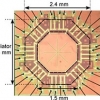Novel Technology to be Unveiled at International Solid-State Circuits Conference
 Jan. 12, 2017 - An innovative new technology developed by a Samueli School professor and his doctoral student will debut next month at a significant IEEE circuits conference.
Jan. 12, 2017 - An innovative new technology developed by a Samueli School professor and his doctoral student will debut next month at a significant IEEE circuits conference.
Electrical Engineering and Computer Science Professor Payam Heydari and graduate student Peyman Nazari have produced a novel high-efficiency, high-power radiator on a chip that will allow unmatched high-power signal generation at very high frequencies, while exhibiting extremely low phase noise (thus producing purer oscillations). Heydari and Nazari will present the sophisticated integrated circuit Feb. 5-9 at the 2017 IEEE International Solid-State Circuits Conference in San Francisco.
“The ISSCC is the flagship IEEE conference where the latest advances in integrated circuits and systems-on-chip are presented,” Heydari says. The conference accepts only papers that present fully functional integrated circuit chips that have demonstrated outstanding performance.
High-efficiency, high-power radiation, at the terahertz and high-end millimeter-wave bands, can penetrate non-conducting materials. But unlike X-ray radiation, it is non-ionizing, meaning it could reduce health hazards in humans. Currently used in short-distance communication, terahertz radiation could have applications in imaging and wireless networking systems, but producing and detecting it is inefficient and impractical. According to Heydari, existing systems cannot produce enough power for next-generation high-speed wireless, medical imaging and security applications.
This new sub-terahertz radiator, however, boasts a novel circularly polarized radiation structure, which performs 10 times better, boosting signal generation and radiation from 0.4 percent to around 4 percent efficiency. “Our radiator enables signal generation and radiation at unprecedented efficiency and high power, and performs extraordinarily better than what is currently available,” Heydari says.
The unique radiator, partially supported by a $300,000 grant from the Samsung Advanced Institute of Technology, could open the door to designing hand-held medical imagers and portable spectroscopy systems.
-- Anna Lynn Spitzer

